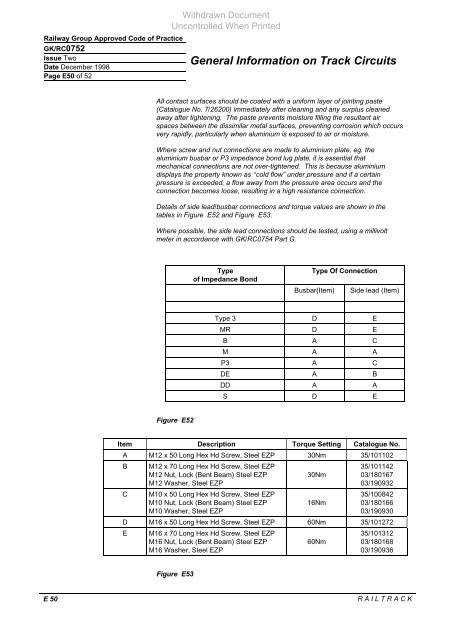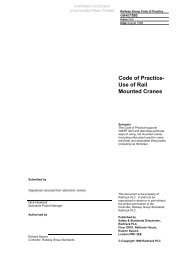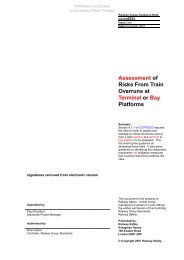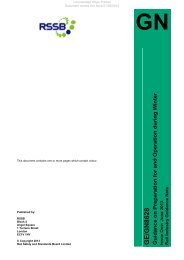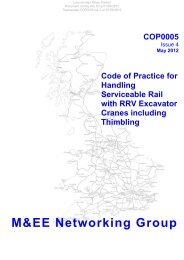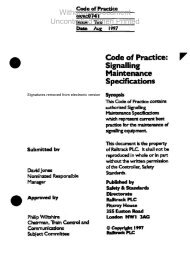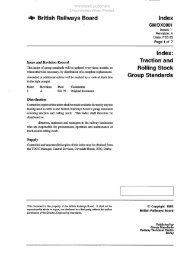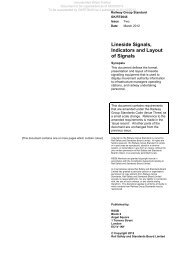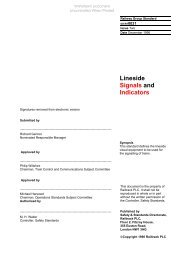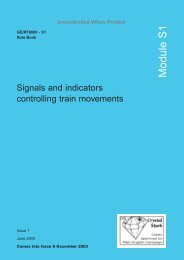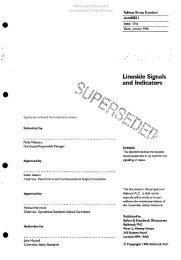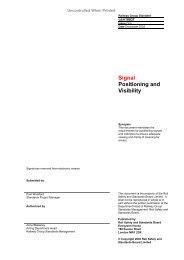General Information on Track Circuits - RGS Online
General Information on Track Circuits - RGS Online
General Information on Track Circuits - RGS Online
Create successful ePaper yourself
Turn your PDF publications into a flip-book with our unique Google optimized e-Paper software.
Railway Group Approved Code of Practice<br />
GK/RC0752<br />
Issue Two<br />
Date December 1998<br />
Page E50 of 52<br />
Withdrawn Document<br />
Unc<strong>on</strong>trolled When Printed<br />
<str<strong>on</strong>g>General</str<strong>on</strong>g> <str<strong>on</strong>g>Informati<strong>on</strong></str<strong>on</strong>g> <strong>on</strong> <strong>Track</strong> <strong>Circuits</strong><br />
All c<strong>on</strong>tact surfaces should be coated with a uniform layer of jointing paste<br />
(Catalogue No. 7/26200) immediately after cleaning and any surplus cleaned<br />
away after tightening. The paste prevents moisture filling the resultant air<br />
spaces between the dissimilar metal surfaces, preventing corrosi<strong>on</strong> which occurs<br />
very rapidly, particularly when aluminium is exposed to air or moisture.<br />
Where screw and nut c<strong>on</strong>necti<strong>on</strong>s are made to aluminium plate, eg. the<br />
aluminium busbar or P3 impedance b<strong>on</strong>d lug plate, it is essential that<br />
mechanical c<strong>on</strong>necti<strong>on</strong>s are not over-tightened. This is because aluminium<br />
displays the property known as ‘‘cold flow” under pressure and if a certain<br />
pressure is exceeded, a flow away from the pressure area occurs and the<br />
c<strong>on</strong>necti<strong>on</strong> becomes loose, resulting in a high resistance c<strong>on</strong>necti<strong>on</strong>.<br />
Details of side lead/busbar c<strong>on</strong>necti<strong>on</strong>s and torque values are shown in the<br />
tables in Figure E52 and Figure E53.<br />
Where possible, the side lead c<strong>on</strong>necti<strong>on</strong>s should be tested, using a millivolt<br />
meter in accordance with GK/RC0754 Part G.<br />
Figure E52<br />
Type<br />
of Impedance B<strong>on</strong>d<br />
Type Of C<strong>on</strong>necti<strong>on</strong><br />
Busbar(Item) Side lead (Item)<br />
Type 3 D E<br />
MR D E<br />
B A C<br />
M A A<br />
P3 A C<br />
DE A B<br />
DD A A<br />
S D E<br />
Item Descripti<strong>on</strong> Torque Setting Catalogue No.<br />
A M12 x 50 L<strong>on</strong>g Hex Hd Screw, Steel EZP 30Nm 35/101102<br />
B M12 x 70 L<strong>on</strong>g Hex Hd Screw, Steel EZP<br />
35/101142<br />
M12 Nut, Lock (Bent Beam) Steel EZP<br />
30Nm<br />
03/180167<br />
M12 Washer, Steel EZP<br />
03/190932<br />
C M10 x 50 L<strong>on</strong>g Hex Hd Screw, Steel EZP<br />
35/100842<br />
M10 Nut, Lock (Bent Beam) Steel EZP<br />
16Nm<br />
03/180166<br />
M10 Washer, Steel EZP<br />
03/190930<br />
D M16 x 50 L<strong>on</strong>g Hex Hd Screw, Steel EZP 60Nm 35/101272<br />
E M16 x 70 L<strong>on</strong>g Hex Hd Screw, Steel EZP<br />
35/101312<br />
M16 Nut, Lock (Bent Beam) Steel EZP<br />
60Nm<br />
03/180168<br />
M16 Washer, Steel EZP<br />
03/190936<br />
Figure E53<br />
E 50 R A I L T R A C K


